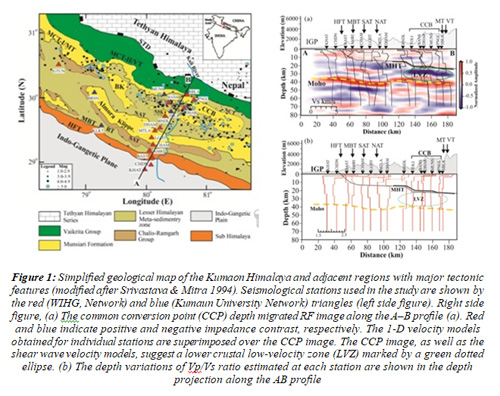 Scientists have unearthed large concentrations of micro and moderate magnitude earthquakes in the Dharchula region and adjoining areas of the Kumaon Himalaya due to critical stress in the region and explored the geological structure behind the stress.
Scientists have unearthed large concentrations of micro and moderate magnitude earthquakes in the Dharchula region and adjoining areas of the Kumaon Himalaya due to critical stress in the region and explored the geological structure behind the stress.
The region between the Kangra (1905) and Bihar-Nepal (1934) earthquakes has not yet experienced great earthquake of magnitude greater than 8.0 since last 500 years, and hence the region is known as Central Seismic Gap (CSG) region. However, the Kumaon Central Himalayan, which belongs to this CSG region, is one of the most seismically active regions of the Himalayan belt that experienced considerable number of moderate and strong earthquakes in the recent past.
Scientists from Wadia Institute of Himalayan Geology (WIHG), Dehradun, an autonomous institute under the Department of Science & Technology, Govt. of India, established a seismological network comprised of 15 broadband seismological stations along the Kali River valley to investigate the subsurface configuration and causes of frequent felt earthquakes in the Kumaon Himalaya region with support from the Ministry of Earth Sciences (MoES), New Delhi.
They found that the stress was caused by a ramp (thin-skinned thrust fault geometry that forms a step-like pattern) on the Main Himalayan Thrust (a gliding plane between two rock masses under the Himalayan Range) beneath the Chiplakot Crystalline Belt, a geological unit in the lesser Himalayas.
The results published recently in the ‘Geophysical Journal International’ revealed the crust to be thinner (38-42 km thick) compared to the similar litho tectonic unit of northwest Himalayas. The ramp structure (of slope around 20o) found on the MHT beneath the Chiplakot Crystalline Belt (CCB) facilitates the exhumation of the CCB. The cluster of seismicity coincides with the ramp on the MHT beneath the CCB, suggesting that the region is critically stressed. Although, in contrast to the brittle upper crust where stress builds up until fracture occurs, a ductile lower crust can dissipate stress by the flow on a geological timescale. Any rapid drop in stress or high strain rates can cause a ductile lower crust to behave in a brittle-elastic manner under the same temperature conditions, according to the WIHG team.
Publication Link:
https://academic.oup.com/gji/advance-article/doi/10.1093/gji/ggaa478/591...






























